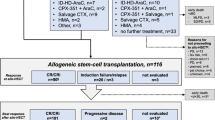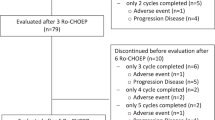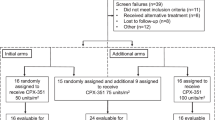Abstract
CPT-11 is an antineoplastic agent which acts as a specific inhibitor of DNA topisomerase 1 and has a broad spectrum of activity in solid tumors. Very few studies have evaluated the activity of CPT-11 in hematological malignancies. We conducted a phase II trial of CPT-11 in 26 patients with high-risk MDS (RAEB 1: n = 4; RAEB 2: n = 9; MDS having progressed to AML: n = 10; CMML: n = 3) who could not receive anthracycline/cytarabine intensive chemotherapy. Induction therapy consisted of four courses of CPT-11 given intravenously at 200 mg/m2 every 2 weeks. Patient characteristics were: median age, 71 (range 51–77); sex, (M/F), 21/5, median % marrow blasts cells, 13.5 (range 7–52). Cytogenetics according to IPSS were: low-risk n = 13, intermediate-risk n = 6, high-risk n = 3, failure or not done n = 4. Six patients stopped treatment after only one or two courses of CPT-11 due to severe infection (n = 2), progressive disease (n = 3), acute lysis syndrome with renal failure (n = 1). In the 20 patients who received at least three cycles of CPT-11, complete remission was achieved in one case, partial remission in four cases, and hematological improvement in three cases with an overall response rate of 33% in the 26 patients. Duration of response was short (median 4 months, range 1–6 months) and median survival was 8 months (range 1–23 months). Digestive toxicity (diarrhea) occurred in 26/89 (29%) courses, but was mild (grade 1, 20% courses; grade 2 or 3, 9% courses). Hematological toxicity was difficult to assess in non-responders because of initial pancytopenia, but all the patients who responded had grade 3/4 hematological toxicity associated with grade ⩾2 infection requiring hospitalization in 18% of the courses. No other major toxicity was observed. Thus CPT-11 has an interesting activity in MDS with excess of blasts; toxicity is easily managed and most patients can be treated in the out-clinic setting. These results suggest that further evaluation of CPT-11 in MDS is warranted.
This is a preview of subscription content, access via your institution
Access options
Subscribe to this journal
Receive 12 print issues and online access
$259.00 per year
only $21.58 per issue
Buy this article
- Purchase on Springer Link
- Instant access to full article PDF
Prices may be subject to local taxes which are calculated during checkout

Similar content being viewed by others
References
Mufti GJ, Stevens JR, Oscier DG, Hamblin TJ, Machin D . Myelodysplastic syndromes: a scoring system with prognostic significance. Br J Haematol 1985; 59: 425–433.
Oscier DG . Myelodysplastic syndromes. Clin Haematol 1987; 1: 389–426.
Fenaux P . Myelodysplastic syndromes. Hematol Cell Ther 1996; 38: 363–380.
Sutton L, Chastang C, Ribaud P, Jouet JP, Kuentz M, Attal M, Rieffers J, Tigaud JM, Rio B, Dauriac C, Legros F, Dreyfus F, Lioure B, Troussard X, Milpied M, Witz F, Oriol P, Cahn JY, Michallet M, Gluckman E, Ifrah N, Pico JL, Vilmer E, Leblond V . Factors influencing outcome in de novo myelodysplastic syndromes treated by allogeneic bone marrow transplantation: a long term study of 71 patients. Société Française de Greffe de Moelle. Blood 1996; 88: 358–365.
Anderson JE, Appelbaum FR, Fisher LD, Schoch G, Shulman H, Anasetti C, Besinger WI, Bryant E, Buckner CD, Doney K, Martin PJ, Sander JE, Sullivan KM, Thomas ED, Witherspoon RP, Hansen JA, Storb R . Allogeneic bone marrow transplantation for 93 patients with myelodysplastic syndrome. Blood 1993; 82: 677–681.
De Witte T, Suciu S, Verhoef G, Labar B, Archimbaud E, Aul C, Selleslag D, Ferrant A, Wijermans P, Mandelli F, Amadori S, Jehn U, Muus P, Boogaerts M, Zittoun R, Gratwohl A, Zwierzina H, Hagemeijer A, Willemze R . Intensive chemotherapy followed by allogeneic or autologous stem cell transplantation for patients with myelodysplstic syndromes or acute myeloid leukemia following MDS. Blood 2001; 98: 2326–23331.
Wattel E, De Botton S, Lao JL, Pruedhomme C, Lepelley P, Bauters F, Fenaux P . Long-term follow-up of de novo myelodysplatic syndromes treated with intensive chemotherapy: incidence of long-term survivors and outcome of partial responders. Br J Haematol 1997; 98: 983–991.
Cheson BD, Simon R . Low-dose ara-C in acute non-lymphocytic leukemia and myelodysplastic syndrome: a review of 20 years’ experience. Semin Oncol 1987; 14: 126–133.
Miller KB, Kyungmann K, Morison FS, Winter JN, Bennet JM, Neiman RS, Head DR, Gassileth PA, O’connell MJ . The evaluation of low-dose cytarabine in the treatment of myelodysplastic syndromes: a phase III intergroup study. Ann Hematol 1992; 65: 162–168.
Denzlinger C, Bowen D, Benz D, Gelly K, Burgger W, Kanz L . Low-dose melphalan induces favorable responses in elderly patients with high-risk myelodysplastic syndromes or secondary acute myeloid leukemia. Br J Haematol 2000; 108: 93–95.
Wijermans P, Lobbert M, Verhoef G, Bosly A, Ravoet C, Andre M, Ferrant A . Low-dose 5-Aza-2′-deoxycytidine, a DNA hypomethylating agent, for the treatment of high-risk myelodysplastic syndrome: a multicenter phase II study in elderly patients. J Clin Oncol 2000; 18: 956–962.
Andreeff M, Stone R, Michaeli J, Young CW, Tong WP, Sogoloff H, Ervin T, Kufe D, Rifkind RA, Mark PA . Hexamethylene bisacetamide in myelodysplastic syndrome and acute myelogenous leukemia: a phase II clinical trial with a differentiation-inducing agent. Blood 1992; 80: 2604–2609.
Beran M, Kantarjian H . Topotecan in the treatment of hematologic malignancies. Semin Hematol 1998; 35: 26–31.
Bearn M, Estey E, O’Brien S, Cortes J, Koller CA, Giles FJ, Kornblau S, Andreef M, Vey N, Pierce SR, Hayes K, Chaun Wong G, Keating M, Kantarjian H . Topotecan and cytarabine is an active combination regimen in myelodysplastic syndromes and chronic myelomonocytic leukemia. J Clin Oncol 1999; 17: 2819–2830.
Cheson BD, Bennet JM, Kantarjian H, Pinto A, Schiffer CA, Nimer SD, Lövenberg B, Beran M, de Witte TM, Stone RM, Mittelman M, Sanz GF, Wijermans PW, Gore S, Greenberg PL . Report of an international working group to standardize response criteria for myelodysplastic syndromes. Blood 2000; 96: 3671–3674.
Abigerges D, Armand JP, Chabot GG, Da Costa L, Fadel E, Cote C, Hérait P, Gandia D . Irinotecan (CPT-11) high-dose escalation using intensive high-dose loperamide to control diarrhea. J Natl Cancer Inst 1994; 86: 446–449.
Greenberg P, Cox C, Le Beau MM, Fenaux P, Morel P, Sanz G, Sanz M, Vallespi T, Hamblin T, Oscier D, Ohyashiki K, Toyama K, Aul C, Mufti G, Bennet JM . International scoring system for evaluating prognosis in myelodysplastic syndromes. Blood 1997; 89: 2079–2088.
Arbuck SG, Takimoto CH . An overview of topoisomerase I targeting agents. Semin Hematol 1998; 35: 3–12.
Pommier Y . DNA topoisomerase I and II in cancer chemotherapy: update and perspective. Cancer Chemother Pharmacol 1993; 32: 103–108.
Ohno R, Okada K, Masaoka T, Kuramato A, Arima T, Yoshida Y, Ariyoshi H, Ichimaru M, Sakai Y, Oguro M, Ito Y, Morishima Y, Yokomaku S, Ota K . An early phase II study of CPT-11: a new derivative of camptothecin, for the treatment of leukemia and lymphoma. J Clin Oncol 1990; 8: 1907–1912.
Niitsu N, Iijima K, Chizuka A . Combination therapy with irinotecan (CPT-11), mitoxantrone, and dexamethasone in relapsed or refractory non-Hodgkin’s lymphoma: a pilot study. Ann Hematol 2001; 80: 411–416.
Saotome T, Takagi T, Sakai C, Kumagai K, Tamaru J . Combination chemotherapy with irinotecan and adriamycin for refractory and relapsed non-Hodgkin’s lymphoma. Ann Oncol 2000; 11: 115–116.
Tsuda H, Takatsuki K, Ohno R, Masaoka T, Okada K, Shirakawa S, Ohashi Y, Ota K . Treatment of adult T-cell leukemia-lymphoma with irinotecan hydrochloride (CPT-11). Br J Cancer 1994; 70: 771–774.
Rothenberg ML, Kuhn JG, Burris HA 3rd, Nelson J, Eckardt JR, Tristan-Morales M, Hilsenbeck SG, Weiss GR, Smith LS, Rodriguez GI . Phase I and pharmacokinetic trial of weekly CPT-11. J Clin Oncol 1993; 11: 2194–21204.
Abigerges D, Chabot GG, Armand JP, Hérait P, Gouyette A, Gandia D . Phase I and pharmacologic studies of the camptothecin analog irinotecan administered every 3 weeks in cancer patients. J Clin Oncol 1995; 13: 210–221.
Author information
Authors and Affiliations
Rights and permissions
About this article
Cite this article
Ribrag, V., Suzan, F., Ravoet, C. et al. Phase II trial of CPT-11 in myelodysplastic syndromes with excess of marrow blasts. Leukemia 17, 319–322 (2003). https://doi.org/10.1038/sj.leu.2402726
Received:
Accepted:
Published:
Issue Date:
DOI: https://doi.org/10.1038/sj.leu.2402726



